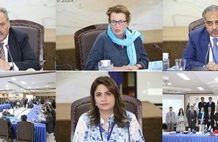PAKISTAN AT A GLANCE
| Population | 185.1 million | 2014 |
| GDP | $246.9 billion | 2014 |
| GDP growth | 5.4% | 2014 |
| Inflation | 7.2% | 2014 |
Pakistan has important strategic endowments and development potential. The country is located at the crossroads of South Asia, Central Asia, China and the Middle East and is thus at the fulcrum of a regional market with a vast population, large and diverse resources, and untapped potential for trade. The increasing proportion of Pakistan’s working-age population provides the country with a potential demographic dividend but also with the critical challenge to provide adequate services and increase employment.
Pakistan faces significant economic, governance and security challenges to achieve durable development outcomes. The persistence of conflict in the border areas and security challenges throughout the country is a reality that affects all aspects of life in Pakistan and impedes development. A range of governance and business environment indicators suggest that deep improvements in governance are needed to unleash Pakistan’s growth potential.
Helped by cheap international oil prices and steady implementation of its reforms program, economy has showed resilience. Despite political uncertainty in July-December 2014 and the September 2014 floods in Punjab that affected agricultural crops, macroeconomic indicators have improved during ongoing FY 2015. Supported by a favorable slump in international oil prices, and stellar implementation of the IMF reform program; growth recovery remains underway, with projected GDP growth now at 4.3-4.6 percent.
Pakistan’s economic growth is showing signs of sustained recovery despite persistent energy constraints. Preliminary data for the first semester of FY 2015 show growth picking up, driven mainly by agriculture and services and despite weaker than expected manufacturing. Growth was better than last year in cotton, wheat and rice crops despite the floods. The service sector was boosted by road transportation, the telecom industry, finance and insurance. Growth of large-scale manufacturing was positive but below last year and arising from strong performance of pharmaceuticals, electronics, automobiles, iron and steel. Nevertheless energy constraints and weak external demand continue to pose challenge for this sector.
Despite some gains Pakistan’s low human development indicators undermine its labor force productivity and economic growth. Pakistan ranks 146 out of 187 countries in the 2014 Human Development Index (HDI) with most indicators lower than most countries in South Asia, and is unlikely to meet the MDGs on several indicators by 2015. Access to education remains low and completion rate for primary education is among the lowest in the world. In 2013 public spending on education was 2.1% of GDP which reflects on the quality, poor teaching and learning outcomes and inadequate infrastructure. Although some provinces (Punjab) have made headway in reducing the gender gap, at 61% girls’ participation at primary level lags 10 percentage points behind boys’. Public spending on health was 1% of GDP in 2013, making Pakistan one of the lowest spenders worldwide. Health outcomes have improved but at a slow pace while nutritional outcomes have not improved over the last two decades, and have even deteriorated for some indicators. The 2011 National Nutrition Survey estimated that the rates of child stunting have not changed since 1965 with 44% of children being stunted; 15% of Pakistani children under 5 suffer from acute malnutrition.
According to official statistics, Pakistan has made substantial progress in reducing poverty. The headcount poverty, according to World Bank staff calculations, fell nationally from 35 percent in 2002 to an estimated 13.6 percent in 2011. Reductions in poverty have been strong in both urban and rural areas, and the fall in rural poverty from 40 to 16 percentage points between 2002 and 2011 is particularly striking. This decline in poverty is confirmed when examining the poverty headcount according to the international poverty line of $1.25 per capita. According to this metric, poverty in Pakistan declined from 36 percent in 2002 to 11 percent in 2011. Pakistan now has the second lowest headcount poverty rate in the South Asia region, after Sri Lanka (4 percent). A large mass of the population moved from just below to just above the official poverty line, which is why small improvements in households’ real consumption have translated into substantial reductions in poverty.
Source: http://www.worldbank.org/en/country/pakistan/overview












